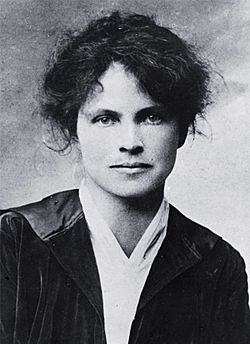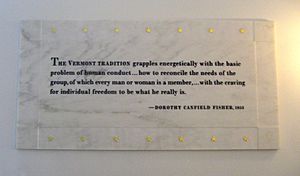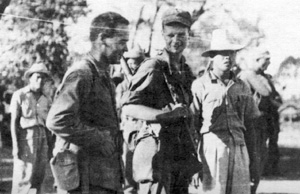Dorothy Canfield Fisher facts for kids
Quick facts for kids
Dorothy Canfield Fisher
|
|
|---|---|

Canfield Fisher as a young woman.
|
|
| Born |
Dorothea Frances Canfield
February 17, 1879 Lawrence, Kansas, US
|
| Died | November 9, 1958 (aged 79) |
| Nationality | American |
| Other names | Dorothea Frances Canfield |
| Occupation | Writer, educator |
| Known for | Montessori method; adult education; Dorothy Canfield Fisher Children's Book Award |
| Spouse(s) |
John Redwood Fisher
(m. 1907) |
| Children | 2 |
Dorothy Canfield Fisher (born February 17, 1879 – died November 9, 1958) was a famous American writer, educator, and social activist. She lived in the early 1900s. Dorothy strongly believed in equal rights for women and people of all races. She also thought learning should continue throughout your whole life.
Eleanor Roosevelt, a former First Lady of the United States, once called Dorothy one of the ten most important women in the country. Dorothy helped bring the Montessori method of teaching children to the U.S. She also led the first program in the country for adults to keep learning. For many years, she helped choose books for the Book of the Month Club, influencing what many people read.
Contents
Dorothy Canfield Fisher's Life Story

Dorothea Frances Canfield was born on February 17, 1879, in Lawrence, Kansas. Her mother, Flavia Camp, was an artist and writer. Her father, James Hulme Canfield, was a university professor and later a university president.
Dorothy spent most of her adult life in Vermont, where her family had a home. Many of her books are set in Vermont.
She studied Romance languages at Ohio State University, the University of Paris, and Columbia University. In 1904, she earned a special degree called a doctorate from Columbia. She was also the first woman to receive an honorary degree from Dartmouth College. This is a special award given to someone for their achievements.
In 1907, Dorothy married John Redwood Fisher. They had two children, a daughter named Sally and a son named Jimmy.
In 1911, Dorothy visited special schools in Rome called "children's houses" started by Maria Montessori. She was very impressed by the Montessori way of teaching. Dorothy helped bring this method to the U.S. by translating Montessori's book into English. She also wrote five of her own books about it.
Dorothy also did important work during World War I. In 1916, she went to France with her husband. While raising her young children in Paris, she helped set up a special printing press. This press made books in Braille for soldiers who had lost their sight. She also created a special home for French children who had to leave their homes because of the war. Her relief work was praised by important people like Eleanor Roosevelt.
Dorothy Canfield Fisher passed away in Arlington, Vermont, in 1958. She was 79 years old.
How Dorothy Fisher Helped Others
Dorothy Canfield Fisher was very active in helping her community and country. She worked to improve education and solve social problems.
She led the first program in the U.S. that helped adults continue their education. During World War I, she did important relief work in France. She opened a home for refugee children and helped print books in Braille for blinded soldiers.
In 1919, she joined the State Board of Education in Vermont. Her goal was to make public schools in rural areas better. She also spent many years working to improve prisons, especially for women. She believed in helping prisoners learn and become better people.
After the war, she led a U.S. committee that helped pardon people who refused to fight in the war for moral reasons. These people were called conscientious objectors. She also helped Jewish educators and professionals move to the U.S. and get financial support.
After her son was killed in World War II, she arranged for two Filipino surgeons to study at Harvard Medical School. These surgeons had tried to save her son's life.
Dorothy Fisher's Connections
Dorothy Canfield Fisher had many connections with other important people and groups.
She had a long friendship with the famous writer Willa Cather. Their letters show how close and sometimes complicated their friendship was. Other writers she knew and wrote to included Richard Wright and Robert Frost.
Dorothy worked with many organizations throughout her life:
- Adult Education Association
- American Youth Commission of the American Council of Education
- Book of the Month Club Committee of Selection
- Honorary Committee of the Women's International League for Peace and Freedom
- The Lighthouse Organization (which helps people who are blind or visually impaired)
- National Institute of Arts and Letters
- Vermont Board of Education
Dorothy Fisher's Children
Dorothy and John Fisher had two children.
Sally was born in 1909. She grew up to be a writer herself, publishing 18 children's books under the name Sally Scott. Dorothy's granddaughter, Vivian Scott, also became a children's book writer.
James, or Jimmy, was born in 1913. He became a surgeon and a captain in the U.S. Army during World War II. He was part of a special unit called the Rangers. They carried out a very brave mission to free POWs (prisoners of war) held at Cabanatuan in the Philippines.
The raid was a big success, and almost all the prisoners were freed. Sadly, Captain Fisher was one of only two Rangers who died during the mission. He was badly wounded and died the next day, on January 31, 1945. His last words were, "Did we get them all out?"
Dorothy Fisher's Lasting Impact
Dorothy Canfield Fisher's work continues to inspire people today.
The Dorothy Canfield Fisher Children's Book Award is a special award named after her. Children themselves vote to choose the winner of this award for new American children's books.
A dormitory (a building where students live) at Goddard College in Vermont is also named after her.
Dorothy Fisher's Books
Dorothy Canfield Fisher was a talented writer who spoke five languages. She wrote novels, short stories, memoirs (stories about her own life), and educational books. She also worked as a literary critic, reviewing books, and as a translator.
Her most famous book today is probably Understood Betsy. It's a children's book about a young orphaned girl who goes to live with her cousins in Vermont. The book is fun to read, but it also shows a school that uses ideas similar to the Montessori method.
Dorothy wrote 22 novels and 18 non-fiction books. A non-fiction book is based on facts, while a novel is a made-up story.
Novels by Dorothy Fisher
- Gunhild (1907)
- The Squirrel-Cage (1912)
- The Bent Twig (1915)
- Understood Betsy (1917)
- The Home-Maker (1924)
- Seasoned Timber (1939)
Short Story Collections by Dorothy Fisher
- Hillsboro People (1915)
- The Real Motive (1916)
- Made-to-Order Stories (1925)
- Four Square (1949)
Non-Fiction Books by Dorothy Fisher
- A Montessori Mother (1912)
- A Montessori Manual (1913)
- Mothers and Children (1914)
- Why Stop Learning? (1927)
- Vermont Tradition (1953)
- Memories of Arlington, Vermont (1957)


